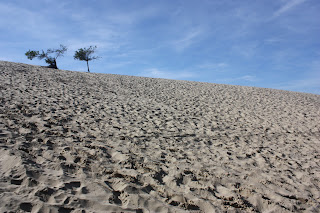Returning home after a long trip is when the reminiscing begins. You no longer see new sights or discover new places, no longer meet new people with “funny” accents or experience the culture they represent. But, you re-live the trip in memory. And, in remembering far away places, you are also reminded of why you return home. The desert is endlessly beautiful in a duo chromatic sort of way. The huge gashes in the earth with their inconceivable striated colours and impossible rock sculptures are breathtaking. The foamy surf that crashes along miles of either soft golden sand or black lava rock is a feast for the eyes and a symphony for the ears. Even the weather, although hotter than comfortably tolerable for this traveler, is dependable. But there’s something both comforting and refreshing in the cool lushness of the Canadian rainforests which paint the coastal mountains green from sea level to summit. And isn’t the anticipation of changing seasons just a little exciting?
Make no mistake, however, we did not wish our way home. We enjoyed every stretch and turn of the road except, perhaps, the noisy concrete freeways, every surprise encounter, except, perhaps, a blinding rainstorm just outside the Grand Canyon , and every person we met, except, perhaps, one indifferent desk clerk. But it’s returning home in light of what you've seen and done on the road that rekindles an appreciation for the familiar. Of course, we also return for practical reasons. Home is where all our “stuff” is. Home is where our work is. Home is where our house and our other cars are. But, it’s just possible that we return home because that’s where friends and family are and, accordingly, where we left our hearts.
Enough gush. Here are a few statistics from our trip to either bore or amuse you. Some are true. Some are not. You decide.
Days on the road: 32
Bottles of wine consumed: 32
Bottles of wine consumed: 32
Days of sunny weather: 30
Amount of rain: 30 minutes
Days over 70 Deg F (21C) 27
Days over 90 Deg F 20
Days over 100 Deg F 7
Days over 110 Deg F 2
Kilometers driven: 7,500
Kilometers of desert crossed: 7,450
Rest stops seen: 150
Rest stops visited: 150
Motorhomes towing vehicles: 50
Motorhomes towing a pickup truck towing a trailer carrying a Jet-Ski: 1
Blown truck tires: 200
Crashed trucks (probably the result of a blown tire): 1
Animals: 1 herd of buffalo, 1 herd of elephant seals, 1 herd of elk, 1 cave bat, 4 mosquitoes.
Road kill: 1,223
Gift shops seen: 450
Gift shops visited: 450
Gift shop purchases: 4
Thanks to everyone who left comments on the blog and to those who just checked in once in awhile to see where we were. I enjoyed writing about this once in a lifetime road trip and sharing it with friends and family. But most of all Frank and I hope you enjoyed the ride.
Until our next trip. . . .























